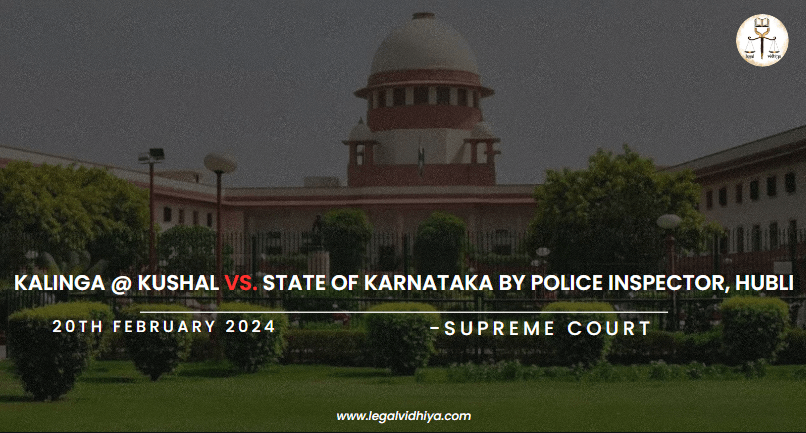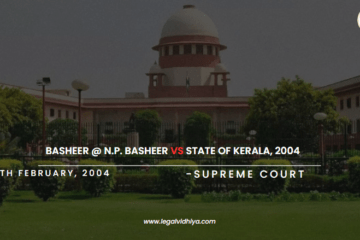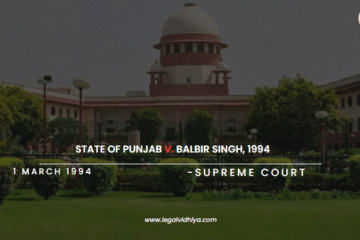
| CITATION | 2024 INSC 124 |
| DATE OF JUDGEMENT | 20th February 2024 |
| COURT | Supreme Court of India |
| APPEALLENT | Kalinga @ Kushal |
| RESPONDENT | State of Karnataka |
| BENCH | Bela M. Trivedi |
INTRODUCTION
In the case of Kalinga @ Kushal Vs State of Karnataka is about the acquittal of a man accused of killing his 2.5-year-old nephew. Master Hrithik, aged 2.5 years, lost his life on 03.11.2022 in Hubli, Karnataka. His father and in this case the complainant filed a complaint and the allegation was against the appellant/accused, who is the younger brother of PW-1. After a full hearing, the trial court acquitted the appellant of the charges against him. The higher court reversed the acquittal order and convicted the appellant. Mystery of Hrithik’s death still persists Case has reached ground Reason: First this Court is in the form of present appeal, which attacks the order dated 28.03.2011 passed by the High Court of Karnataka (Circuit Bench at Dharwad). On 03.11.2002, the son of PW-1 had gone out for playing and went missing. On 14.11.2002, the appellant (also the brother of PW-1) appeared at the house of PW-1 in a drunken state and started blabbering about the missing incident of Hrithik and about mishappening with the child. On the morning of 15.11.2002, the appellant stated that he had murdered Hrithik and thrown his body in the well. Upon reaching the police station, the appellant confessed to the commission of crime as well as the act of throwing the child in the well. Upon the culmination of trial, the Trial Court acquitted all the accused persons vide order dated 30.04.2004 passed by Ld. ASJ-01, Dharwad (Hubli). In Criminal Appeal No. 130/2005.The case includes the Indian Penal Code, 1860, which section 302 punishment for murder, 201 causing disappearance of evidence of offence, or giving false information to screen offender, 363 punishment for kidnapping, 364 kidnapping or abducting in order to murder.
FACTS OF THE CASE
- A boy aged 2.5 years lost his life in 2002 and a complaint was filed by his father against the appellant accused who was his younger brother i.e., paternal uncle of the deceased child. After a full-fledged trial, the Trial Court had acquitted the accused but the High Court reversed the order of acquittal and convicted him. The mystery of the child’s death continued as the matter was before the Apex Court.
- According to the prosecution, the deceased child had gone out for playing and went missing and other family members of him searched for him in and around the locality. Upon finding no trace till evening, a missing complaint was lodged and then after a few days, the accused appeared at the house of the child’s father in a drunken state and started blabbering about the missing incident of the child. Next morning, the accused stated that he had murdered the child and thrown his body in the well. The father took the accused to the police for filing a complaint which led to the registration of FIR. On reaching the police station, the accused confessed to the commission of crime and his voluntary statement in the nature of extra judicial confession was recorded. The accused also took the child’s father and Investigating Officer (IO) to the well where he threw the body. On looking into the well, the dead body was found floating there which was taken out. Thereafter, charges were framed against three accused persons as jewellery articles were taken off from the child’s body and sold off.
- The Supreme Court in view of the facts and circumstances of the case noted, “Notably, it is a peculiar case wherein the appellant has been convicted for the commission of murder without ascertaining the cause of death in a conclusive manner. … the post mortem reveals the time of death within a time frame of 3 to 12 days. Allegedly, the death took place on 03.11.2002. Such a wide time frame concerning the crucial question of time of death raises a serious doubt on the reliability of the post mortem report. When this fact is seen in light of the already existing doubts on the identity of the deceased, one is constrained to take the report with a pinch of salt. More so, this discrepancy again brings into question the element of recovery of the dead body and identity of the deceased.”
- The Court further said that the Trial Court had appreciated the entire evidence in a comprehensive sense and the High Court reversed the view without arriving at any finding of perversity or illegality in the order of the Trial Court. It said that the High Court took a cursory view of the matter and merely arrived at a different conclusion on a re-appreciation of evidence.
- “It is settled law that the High Court, in exercise of appellate powers, may reappreciate the entire evidence. However, reversal of an order of acquittal is not to be based on mere existence of a different view or a mere difference of opinion. To permit so would be in violation of the two views theory, as reiterated by this Court from time to time in cases of this nature”, it held.
- The Court also noted that the entire case of the prosecution is based on circumstantial evidence and the principles concerning circumstantial evidence are fairly settled and are generally referred to as the “Panchsheel” principles. It said that essentially, circumstantial evidence comes into picture when there is absence of direct evidence.
- “For proving a case on the basis of circumstantial evidence, it must be established that the chain of circumstances is complete. It must also be established that the chain of circumstances is consistent with the only conclusion of guilt. The margin of error in a case based on circumstantial evidence is minimal. For, the chain of circumstantial evidence is essentially meant to enable the court in drawing an inference. The task of fixing criminal liability upon a person on the strength of an inference must be approached with abundant caution”, it added.
- The Court observed that to draw an inference of guilt based on such evidence would result into nothing but failure of justice and that the evidence completely fails the test laid down for the acceptability of circumstantial evidence.
- “A reasonable doubt is one which renders the possibility of guilt as highly doubtful. It is also noteworthy that the purpose of criminal trial is not only to ensure that an innocent person is not punished, but it is also to ensure that the guilty does not escape unpunished. A judge owes this duty to the society and effective performance of this duty plays a crucial role in securing the faith of the common public in rule of law. Every case, wherein a guilty person goes unpunished due to any lacuna on the part of the investigating agency, prosecution or otherwise, shakes the conscience of the society at large and diminishes the value of the rule of law”, it said.
- The conviction of the appellant is largely based on the extra judicial confession allegedly made by him before PW-1. So far as an extra judicial confession is concerned, it is considered as a weak type of evidence
- In Chandrapal v. State of Chattisgarh6, this Court reiterated the evidentiary value of an extra judicial confession in the following words:
At this juncture, it may be noted that as per Section 30 of the Evidence Act, when more persons than one is being tried jointly for the same offence, and a confession made by one of such persons affecting himself and some other of such persons is proved, the court may take into consideration such confession as against such other person as well as against the person who makes such confession.
- However, this court has consistently held that an extra judicial confession is a weak kind of evidence and unless it inspires confidence or is fully corroborated by some other evidence of clinching nature, ordinarily conviction for the offence of murder should not be made only on the evidence of extra judicial confession.
- As held in the case of the State of M.P. Through CBI v. Paltan Mallah, the extra judicial confession made by the co-accused could be admitted in evidence only as a corroborative piece of evidence. In absence of any substantive evidence against the accused, the extra judicial confession allegedly made by the co-accused loses its significance and there cannot be any conviction based on such extra judicial confession of the co-accused.”
- The Court concluded that the case does not fall in the category of a light-hearted acquittal which is shunned upon in law and that the High Court erred in reversing the decision of acquittal because the evidence of prosecution, at best, makes out a case for suspicion, and not for conviction.
- Accordingly, the Apex Court disposed of the appeal and set aside the conviction of the appellant.
ISSUE
Whether the extra judicial confession of the appellant/accused was admissible, credible and sufficient for convictions of the accused thereon?
- Whether the testimony of PW-1 could be termed as reliable and trustworthy?
- Whether the claim of circumstantial evidence is complete and consistent for arriving at the conclusion of guilt?
APPELLANT`S ARGUMENTS
The appellant’s confession and the details provided by PW-1 are crucial in this case. The discrepancies in the statements and the sequence of events highlighted by the appellant raise valid points for consideration. The absence of accused no. 3 in the initial complaint (Ex.P1) despite the later disclosure is indeed a significant contradiction that needs to be addressed. The issues raised regarding the extra judicial confession, the description of clothes, and the sequence of events during the arrest are essential factors that should have been carefully examined by the High Court. The appellant’s plea for a fair reconsideration of the evidence and the benefit of doubt in case of multiple interpretations seems reasonable in ensuring justice is served correctly.
RESPONDENT`S ARGUMENTS
For the Accused (Kushal): The defence argued that the extra-judicial confession is a weak form of evidence and should not be heavily relied upon unless corroborated by other strong evidence. It was contended that the confession, allegedly made to PW-1 (the father of the deceased), lacked credibility due to inconsistencies in the testimony and the unnatural conduct of PW-1. The defence highlighted the unreliable nature of the witness (PW-2) who was present during the recovery of the dead body, and contradictions regarding the arrest and last seen theory. They also raised doubts about the identity of the dead body recovered from the well. The defence maintained that the evidence on record did not meet the standards required for circumstantial evidence and that the Trial Court’s acquittal should stand.
ANALYSIS
The tragic case that unfolded in Karnataka, the appellant, the uncle of the deceased 2.5-year-old Hrithik, found himself at the centre of a legal battle. The child had gone missing and was later discovered dead in a well. The Trial Court initially acquitted the appellant, citing discrepancies in witness testimonies and circumstantial evidence. However, the High Court later reversed this decision, basing its judgment on the voluntary extra-judicial confession made by the accused and the recovery of the child’s body.
The credibility of the appellant’s confession became a pivotal point of discussion during the court analysis. The High Court, while acknowledging minor discrepancies in witness testimonies, leaned on the strength of the confession, supported by corroborative evidence presented by the State. However, doubts were cast upon the confession’s reliability, as well as the consistency of the appellant’s statements, the circumstances of his arrest, and the recovery process of the deceased’s body.
The court emphasized the need for caution and corroboration when considering extra-judicial confessions. It delved into the intricacies of the case, noting various versions and inconsistencies in witness testimonies. The High Court’s decision to overturn the Trial Court’s acquittal was criticized for lacking evidence of perversity or illegality in the original judgment.
Ultimately, the judgment turned on the acceptance of evidence. In light of doubts raised regarding the confession and the overall case presented by the prosecution, the court concluded that the evidence failed to meet the necessary standards for acceptability. The restoration of the Trial Court’s decision led to the appellant’s acquittal, underscoring the importance of ensuring a strong and reliable evidentiary foundation, particularly in cases relying heavily on circumstantial evidence and confessions.
JUDGEMENT
The Supreme Court ultimately held that the extra-judicial confession was not supported by other evidence on record and thus could not be treated as a strong piece of evidence for conviction. The Court found the testimony of PW-1 to be unreliable and the evidence insufficient to meet the threshold for circumstantial evidence. Consequently, the Supreme Court set aside the High Court’s judgment that had reversed the acquittal, and restored the order of the Trial Court, acquitting the appellant.
CONCLUSION
So, the High Court made a mistake in reversing the acquittal. The prosecution’s arguments only raised doubts, not enough for conviction. Therefore, the High Court’s decision is overturned. The Trial Court’s order is reinstated, and the Appellant is cleared of all charges. If the Appellant is in custody, they should be released immediately. The appeal is concluded as mentioned. Any pending applications will also be addressed.
REFERENCE
- https://indiankanoon.org/doc/184499048/
- https://main.sci.gov.in/supremecourt/2011/19076/19076_2011_8_1501_50637_Judgement_20-Feb-2024.pdf
-Written by RIYA SHARMA
Disclaimer: The materials provided herein are intended solely for informational purposes. Accessing or using the site or the materials does not establish an attorney-client relationship. The information presented on this site is not to be construed as legal or professional advice, and it should not be relied upon for such purposes or used as a substitute for advice from a licensed attorney in your state. Additionally, the viewpoint presented by the author is of a personal nature.




0 Comments